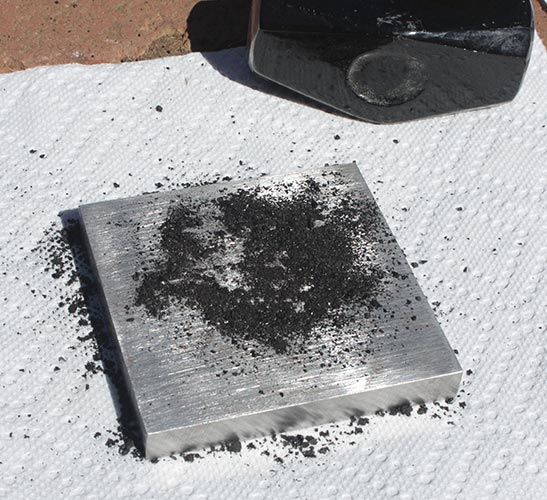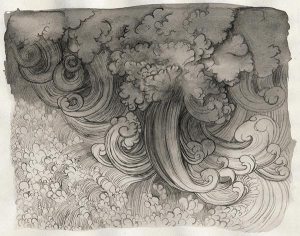
When I was looking for interesting rocks at a local rock shop to grind into pigment I found a piece of anthracite. I knew various forms of coal or related materials could be made into paint, so I thought I’d try it. I don’t know what the lightfastness of this is, but it’s probably not very good. Even so, I really like this slightly brownish black watercolor paint.
The wet on wet swatch is my favorite because it was so inert in the water that it easily retained interesting visual textures. In the light wash you can see that there’s a few very tiny loose particles in the paint. I just wiped one of them off the paper, so maybe I needed to mull the paint longer. The pigment had a little resistance to mixing with the wet ingredients, but not nearly as much as when I tried making viridian watercolor a few weeks ago.

Here’s the tools I used for making the pigment. The mortar and pestle are stainless steel and I only use it for grinding pigment. This is the second time I’ve used it like this. The first time I was doing this exact process but with some pieces of tiger’s eye a few weeks ago.
The goggles are obviously to protect my eyes, since little pieces of anthracite kept flying everywhere. The steel block that the anthracite is on is meant for making jewelry. I ordered it from Amazon specifically for doing this kind of thing. The hammer is 3 lb because with more weight I can move the hammer more slowly, giving me more control, and still have the same impact force.

The anthracite has a lot of interesting textures in it. In some places the pattern of the cracks almost looks like wood, and in other places it’s very glossy and looks like obsidian.

I found that tapping very lightly with the hammer was best, even though it seemed slow, because otherwise the little pieces would fly everywhere. Holding the hammer just below its head gave me more control. I found that holding my hand on one side of the block and tapping with the hammer angled toward that side helped a lot to prevent pieces from flying off the block. It’s not necessary to break it down into a fine powder at this point, a coarse powder is all that’s needed.

Here’s the finished pigment, ground much finer with the mortar and pestle. It turned out to not be as fine as I thought. When I actually put this under the muller to make paint it still felt pretty coarse, but it smoothed out a bit as I mulled it.
I still have most of the anthracite left, which I may grind up later and use to make oil paint.

fascinating results and textures, especially wet on wet… i like that mortar and pestle
The mortar and pestle works out well because it’s a largish size with a decently long handle (you can actually wrap your hand around it and not have your hand down inside the mortar) and the bulbous end gives a lot more surface to have the pigment under so it can be ground instead of just stirring it. One thing I noticed with the tiger’s eye that I tried grinding in this is that even stainless steel can be scratched.
Looking good!
Thanks ^_^
Fascinating blog, thank you
Thanks 🙂
Very cool! Thanks for sharing your experiments!
Sure, and I have more experiments planned. Maybe some malachite? 🙂
I enjoy your blog as I experiment with mixing my own watercolor pigments. Where did you find that giant mortar and pestle? I haven’t had any luck find one of that size yet. Thanks.
Thanks, it was from a health food store and I’m not sure the brand or where I’ve put it, but it looks like there’s a stainless steel one on Amazon from Mastrad that’s either the same or very close. The steel slab next to the mortar is about 3″ or 3.5″ for reference. One problem I had was that certain rocks are harder than steel, so the bottom of the mortar ended up getting a large patch where everything was thoroughly scuffed from thousands of scratches. A granite or quartz mortar and pestle would be harder than steel. At a latter date I tried grinding more of this same piece of anthracite in a large granite mortar and it didn’t seem to scratch but it does look like the dust of the anthracite, which is also very hard, may have become imbedded into the granite.